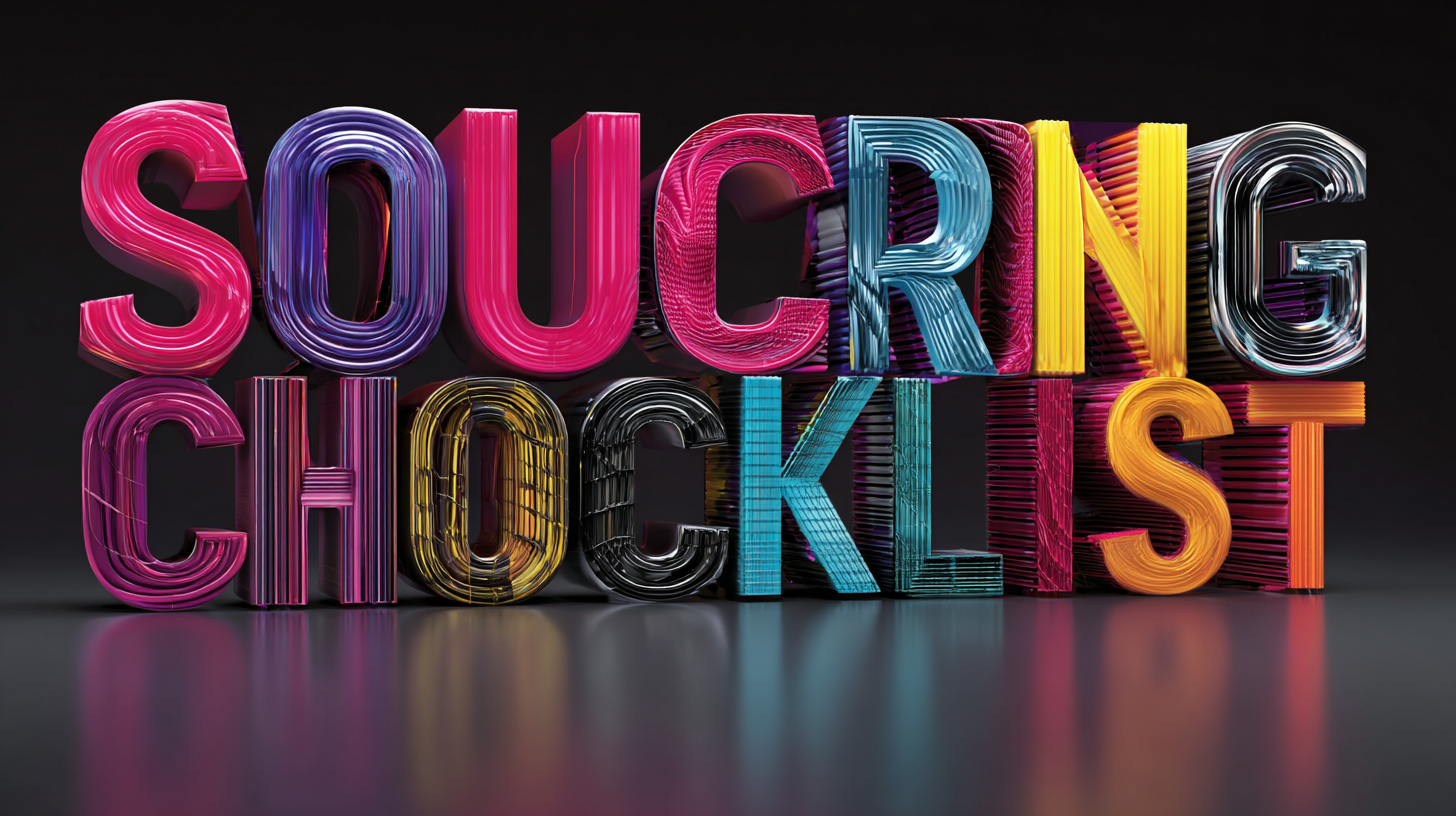
The global sourcing landscape has evolved significantly, with the demand for high-quality products like the 1-1418390-1 rising steadily across various industries. According to a recent report by McKinsey, around 80% of companies are actively searching for reliable suppliers who can deliver both quality and cost-effectiveness, particularly in the electronics and manufacturing sectors. China's reputation as a significant player in this arena—often dubbed "China’s intelligent manufacturing"—has led to a surge in exports, with estimates suggesting a growth of over 15% in the last year alone. As businesses strive to enhance their product offerings and maintain competitive advantages, sourcing the right components, such as the 1-1418390-1, has become crucial. This blog will provide an ultimate checklist to guide you through the process of sourcing this vital product globally while ensuring quality assurance and leveraging China’s manufacturing capabilities.

Quality sourcing plays a pivotal role in global manufacturing, impacting everything from cost-efficiency to product reliability. In an increasingly interconnected world, manufacturers must prioritize the selection of high-quality suppliers to ensure that their products meet both consumer expectations and industry standards. Sourcing the best components, such as the 1-1418390-1 product, not only enhances a manufacturer’s reputation but also contributes significantly to the overall efficiency of production processes.

Moreover, understanding the nuances of quality sourcing allows businesses to mitigate risks associated with international procurement. By establishing strong partnerships with trusted suppliers, manufacturers can ensure a consistent supply of premium goods while also safeguarding against potential disruptions in the supply chain. In today’s competitive market, the emphasis on quality sourcing is paramount—not just for achieving operational excellence, but also for fostering long-term relationships with customers who seek value and reliability in every product they purchase.
When selecting a manufacturing partner in China, several key considerations can significantly impact the success of your sourcing strategy, especially for products like the 1-1418390-1. First, evaluate the manufacturer's experience and expertise in producing similar products. Look for a company that specializes in your target product category and has a proven track record of quality and reliability. This will ensure that the manufacturing partner understands the specific requirements of your product.
Tip: Request case studies or references from previous clients to assess the manufacturer's capabilities. Additionally, visiting the factory can provide firsthand insights into their operational processes and quality control measures.
Next, communication is critical in any manufacturing relationship. Ensure that your chosen partner has proficient English-speaking staff or translation services, as misunderstandings can lead to costly errors. Regular and clear communication channels will help maintain alignment on project timelines, product specifications, and any potential issues that may arise.
Tip: Set up a structured communication plan that includes regular updates and meetings to ensure both parties stay informed about the project's progress and can address challenges promptly.
When sourcing the best 1-1418390-1 product globally, evaluating manufacturing capabilities and certifications is essential for ensuring product excellence. A key aspect of this evaluation is understanding the operational excellence that a manufacturer can offer. As businesses adopt Industry 4.0 technologies, the integration of advanced tools can enhance process efficiencies, thus optimizing the manufacturing cycle from engineering to production. A focus on digital transformation not only improves operations but also aligns with the growing demand for high-quality products that comply with safety standards and regulations.

Moreover, the role of a robust supply chain cannot be overstated in this context. It plays a critical part in procurement, planning, logistics, and sustainability efforts, ensuring that every component of the product meets the required specifications. Companies must also invest in talent development and skills improvement within the workforce. With the right training and certifications, such as Six Sigma, organizations can achieve significant advancements in quality management and process control, ultimately leading to superior product outcomes.
Maintaining consistent quality control throughout the production process is crucial when sourcing the best 1-1418390-1 product globally. Implementing a robust quality management system (QMS) is the first step. This includes clearly defined quality standards and procedures that all manufacturing partners must adhere to. Regular training sessions for staff involved in production can ensure that everyone is aligned with these standards, reducing the risk of discrepancies and enhancing overall product integrity.
In addition to internal training, it is essential to conduct regular audits and inspections throughout the production cycle. Partnering with local quality control experts can facilitate these assessments, providing valuable insights into any potential weaknesses in the production line. Utilizing advanced tracking technology can also help monitor product quality in real time, allowing for quick adjustments if issues arise. By investing in these strategies, companies can foster trust with their suppliers and customers, ensuring that the products meet the highest quality benchmarks consistently across all regions.
| Criteria | Details | Importance Level | Notes |
|---|---|---|---|
| Supplier Reputation | Evaluate historical performance and customer feedback. | High | Research online reviews and ratings. |
| Quality Certifications | Check for ISO or industry-specific certifications. | High | Certifications should be up-to-date. |
| Production Capacity | Assess the supplier's ability to meet your order volume. | Medium | Ensure they can scale if needed. |
| Lead Time | Determine the time required for production and delivery. | Medium | Factor in potential delays. |
| Price Competitiveness | Compare pricing with industry averages. | Medium | Consider total cost including shipping. |
| Communication | Evaluate responsiveness and clarity of communication. | High | Good communication can solve many issues. |
| Local Regulations | Understand compliance with local regulations and standards. | High | Avoid legal complications. |
| Sample Testing | Request samples to evaluate product quality. | High | Ensure quality meets your standards before bulk order. |
Navigating cultural and communication barriers is essential for establishing successful global sourcing relationships, especially when sourcing products like the 1-1418390-1. According to a study by Statista, 70% of sourcing professionals reported that cultural misunderstandings can significantly hinder the negotiation process. This statistic underscores the importance of cultural competence in global sourcing. Understanding the values, traditions, and business etiquette of different regions can facilitate smoother interactions and foster trust among partners.
Moreover, effective communication is critical in mitigating risks associated with global sourcing. A report from Deloitte indicates that 60% of international sourcing failures are attributed to poor communication strategies. Adapting communication styles to bridge cultural divides—such as being aware of differences in directness or hierarchy—can enhance collaboration and lead to more favorable outcomes. Utilizing tools like multilingual support and culturally tailored marketing materials can further strengthen cross-border relationships, paving the way for sourcing the best products on a global scale.
